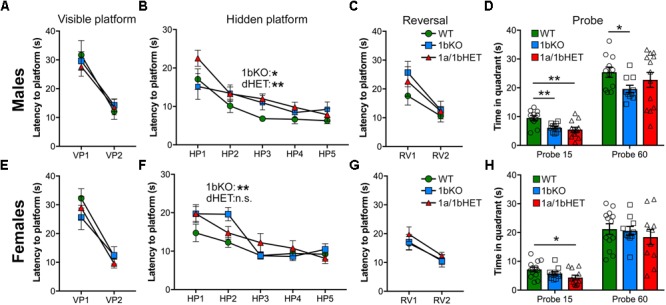FIGURE 4.

CC2D1B is involved in spatial memory formation and retention with mild male-specificity. Hippocampus-dependent spatial memory was assessed in 1bKO and 1a/1bdHET mice via the Morris Water Maze test. Spatial learning was measured as latency to escape in three different stages, visible platform (VP), hidden platform (HP), or the reversal (RV) of the HP position. No deficits were shown by males (A) or females (E) of any genotype in identifying the platform in the VP trial. (B) Both 1bKO and 1a/1bHET males showed a delay in learning the location of the HP, and a similar deficit was present in 1bKO females (F). (C,G) No differences were found in the RV during the test. (D,H) Spatial memory retention was measured between the HP and RV trials by the time spent swimming in the quadrant where the platform was previously located. Significant spatial memory impairment was found in the 1bKO male mice compared to WT both during the first 15 s and at the end of the trial after 60 s, while female 1bKO mice showed no deficit. 1a/1bHET males and females spent less time looking for the platform during the first 15 s, but subsequently recovered. Two-way ANOVA with repeated measures was used for analysis of the HP phase. Multiple t-tests with equal variance were uses for individual timepoints and probe analysis ∗p < 0.05, ∗∗p < 0.01.
